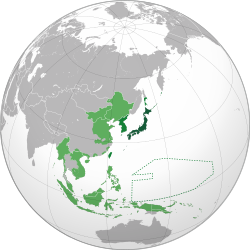Japanese Occupation of Indonesia
| Japanese-occupied Dutch East Indies | ||||||||||||
|
Ranryō Higashi Indo 蘭領東印度 |
||||||||||||
| Military occupation by the Empire of Japan | ||||||||||||
|
||||||||||||
|
Motto Hakkō ichiu (八紘一宇) |
||||||||||||
|
Anthem Kimigayo |
||||||||||||
|
The Empire of Japan in 1942.
|
||||||||||||
| Capital | Djakarta | |||||||||||
| Languages | Japanese, Indonesian | |||||||||||
| Government | Military occupation | |||||||||||
| Historical era | World War II | |||||||||||
| • | Dutch capitulation | 8 March 1942 | ||||||||||
| • | East Highway Asian War | 1941–1945 | ||||||||||
| • | First Battle of the Java Sea | 27 February 1942 | ||||||||||
| • | Second Battle of the Java Sea | 1 March 1942 | ||||||||||
| • | PETA insurgency | 14 February 1945 | ||||||||||
| • | Surrender of Japan | 2 September 1945 | ||||||||||
| • | Independence proclaimed | 17 August 1945 | ||||||||||
| Currency | Netherlands Indian roepiah | |||||||||||
|
||||||||||||
| Today part of |
|
|||||||||||
(八紘一宇)
The Japanese Empire occupied the Dutch East Indies, now Indonesia, during World War II from March 1942 until after the end of the War in 1945. The period was one of the most critical in Indonesian history. Under German occupation, the Netherlands had little ability to defend its colony against the Japanese army, and less than three months after the first attacks on Borneo, the Japanese navy and army overran Dutch and allied forces. Initially, most Indonesians joyfully welcomed the Japanese, as liberators from their Dutch colonial masters. The sentiment changed, as Indonesians were expected to endure more hardship for the war effort. In 1944–1945, Allied troops largely bypassed Indonesia and did not fight their way into the most populous parts such as Java and Sumatra. As such, most of Indonesia was still under Japanese occupation at the time of their surrender, in August 1945.
The occupation was the first serious challenge to the Dutch in Indonesia and ended the Dutch colonial rule, and, by its end, changes were so numerous and extraordinary that the subsequent watershed, the Indonesian National Revolution, was possible in a manner unfeasible just three years earlier. Unlike the Dutch, the Japanese facilitated the politicisation of Indonesians down to the village level. Particularly in Java and, to a lesser extent, Sumatra, the Japanese educated, trained and armed many young Indonesians and gave their nationalist leaders a political voice. Thus, through both the destruction of the Dutch colonial regime and the facilitation of Indonesian nationalism, the Japanese occupation created the conditions for claiming Indonesian independence within days of the Japanese surrender in the Pacific. However, the Netherlands sought to reclaim the Indies, and a bitter five-year diplomatic, military and social struggle ensued, resulting in the Netherlands recognising Indonesian sovereignty in December 1949.
...
Wikipedia


